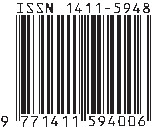Peran Mise-en-scene dalam mendukung perubahan kepribadian tokoh Spencer dalam film Jumanji: Welcome to the Jungle
Abstract
This article aims to discuss the personality change of the character Spencer in the movie Jumanji: Welcome to the Jungle through the analysis of mise-en-scene aspects. The research used a qualitative- descriptive method. The researcher applied Carl Rogers' personality theory to analyze Spencer's personality change, as well as mise-en-scene theory to analyze the visual aspects that illustrate the change. The results showed that Spencer's personality change can be categorized into three phases: before entering the game, while in the game, and after exiting the Jumanji game. The mise-en-scene elements that support Spencer's personality change include the setting and props, costumes and makeup, and the players and their movements. Spencer, who had an introverted personality, lacked confidence, and wanted to gain recognition from his friends before entering the Jumanji game, changes to become more confident and gain recognition after exiting the Jumanji game. Spencer's adventures in the Jumanji game encouraged him to self-actualize, thus changing his personality for the better.
References
Amalia, L. 2013. “Menjelajahi Diri dengan Teori Kepribadian Carl R. Rogers”, Muaddib, 3(1):87-99.
Arikunto, S. 2010. Prosedur Penelitian Suatu Pendekatan Praktek. Jakarta: Rineka Cipta.
Astuti, Y. S., N. P. Wijaya, dan Wajihuddin. 2024. “The Role of Mise En Scene in Visualizing Discrimination Scenes in Miracle in Cell Numb. 7”, International Journal of Science and Human Research, 7: 352-355.
Bordwell, D. dan K. Thompson. 2009. Film Art an Introduction. Edisi Kesembilan. New York: McGraw-Hill Education.
Erilia, E. 2022. “Sinopsis Jumanji: Welcome to the Jungle dan Aksi Dwayne Johnson”. https://tirto.id/sinopsis-jumanji-welcome-to-the-jungle-dan-aksi-dwayne-johnson- gzcZ. diakses pada 18 Maret 2024.
Fatwikiningsih, N. 2020. Teori Psikologi Kepribadian Manusia. Yogyakarta: ANDI.
Hikmawati, F. 2020. Metodologi Penelitian. Depok: Rajawali Pers.
Ibad, G. I. 2023. “Aspek Mise En Scene Dalam Menggambarkan Perubahan Perilaku Tokoh Maria Pada Film Look Away”. Skripsi. Jember: Program Studi Televisi dan Film Fakultas Ilmu Budaya Universitas Jember.
Kriyantono, R. 2008. Teknik Praktis Riset Komunikasi. Jakarta: Kencana Prenada Media.
Maheswar, I. 2021. “3 Fakta Menarik Jumanji: Welcome to the Jungle, Film tentang Petualangan Fantasi di Alam Liar”. https://www.liputan6.com/showbiz/read/4711106/3-fakta-menarik-jumanji-welcome- to-the-jungle-film-tentang-petualangan-fantasi-di-alam-liar?page=4/. diakses pada 30 November 2023.
Nisa, B. 2022. Metodologi Penelitian. Banyumas: Pena Persada Redaksi.
Nurgiyantoro, B. 2013. Teori Pengkajian Fiksi. Yogyakarta: Gadjah Mada University Press.
Pratista, H. 2017. Memahami Film. Yogyakarta: Homerian Pustaka.
Pradini, L. 2018. “Peran Mise En Scene Terhadap Perubahan Perilaku Tokoh Pendukung dalam Film Horor MAMA”. Skripsi. Jember: Program Studi Televisi dan Film Universitas Jember.
Putri, A. 2017. “Resensi Film Jumanji: Welcome to the Jungle, Permainan Lama dengan Gaya Baru”. https://www.tabloidbintang.com/film-tv- musik/ulasan/read/87179/resensi-film-jumanji-welcome-to-the-jungle-permainan- lama-dengan-gaya-baru. diakses pada 10 Januari 2024.
Rosyidi, H. 2015. Psikologi Kepribadian (Paradigma Traits, Kognitif, Behavioristik, dan Humanistik). Surabaya: Jaudar Press.
Saleh, S. 2019. “Teknik Analisis Data”, Analisis Data Kualitatif (Sira Anak Saleh), 14: 16.
Sasmita. I. 2022. “Mise En Scene Iklan Rinso Episode Yuk Mulai Bijak Plastik Tahun 2019 dalam Mendukung Kepribadian Tokoh Cucu”. Skripsi. Jember: Program Studi Televisi dan Film Universitas Jember.
Sugiyono. 2013. Metode Penelitian Kuantitatif, Kualitatif, dan R&D. Bandung: Alfabeta. Sujarweni, W. 2014. Metodologi Penelitian : Lengkap, Praktis, dan Mudah. Yogyakarta: Pustaka Baru Press.
Yanti, F. 2021. Psikologi Komunikasi. Lampung: Agree Media Publishing.
Zoebazary, I. 2016. Kamus Istilah Televisi dan Film. Jember: Universitas Jember.

This work is licensed under a Creative Commons Attribution-ShareAlike 4.0 International License.
SEMIOTIKA has CC-BY-SA or an equivalent license as the optimal license for the publication, distribution, use, and reuse of scholarly work. Authors who publish with this journal retain copyright and grant the journal right of first publication with the work simultaneously licensed under a Creative Commons Attribution-ShareAlike 4.0 International License that allows others to share the work with an acknowledgment of the work's authorship and initial publication in this journal.
Attribution-ShareAlike
CC BY-SA










